Abdul Hamid II
Abdul Hamid II or Abdülhamid II (Ottoman Turkish: عبد الحميد ثانی, romanized: Abdü’l-Ḥamîd-i-sânî; Turkish: II. Abdülhamid; 21 September 1842 – 10 February 1918) reigned as the 34th Sultan of the Ottoman Empire - the last Sultan to exert effective control over the fracturing state.[3] He oversaw a period of decline, with rebellions (particularly in the Balkans), and he presided over an unsuccessful war with the Russian Empire (1877-1878) followed by a successful war against the Kingdom of Greece in 1897. Hamid II ruled from 31 August 1876 until his deposition shortly after the 1908 Young Turk Revolution, on 27 April 1909. In accordance with an agreement made with the Republican Young Ottomans, he promulgated the first Ottoman Constitution of 1876 on 23 December 1876,[4] which was a sign of progressive thinking that marked his early rule. However, in 1878, citing disagreements with the Parliament,[4] he suspended both the short-lived constitution and the Parliament.
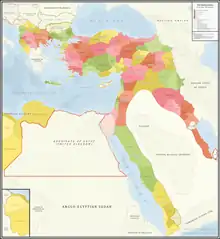
The modernization of the Ottoman Empire continued during his reign, including reform of the bureaucracy, the extension of the Rumelia Railway and of the Anatolia Railway, and the construction of the Baghdad Railway and of the Hejaz Railway. In addition, systems for population registration and control over the press were established, along with the first local modern law-school in 1898. The most far-reaching of the reforms occurred in education: many professional schools were established for fields including the law, arts, trades, civil engineering, veterinary medicine, customs, farming, and linguistics. Although Abdul Hamid II closed Istanbul University in 1881, it re-opened in 1900, and a network of secondary, primary, and military schools was extended throughout the empire. German firms played a major role in developing the Empire's railway- and telegraph-systems.[4] During Abdul Hamid's reign the Ottoman Empire became bankrupt, leading to the establishment of Ottoman Public Debt Administration in 1881.
Outside the Ottoman Empire, Sultan Abdul Hamid II gained the nickname the Red Sultan or the Bloody Sultan because of the Hamidian massacres of Armenians and Assyrians of 1894-1896 and the use of the secret police to silence dissent and the Young Turks movement.[5] Large sections of the Ottoman intelligentsia sharply criticised and opposed him. [6] Loyal citizens called him the Grand Khagan (Turkish: Ulu Hakan) for his extraordinary efforts in modernising the empire and in keeping it intact in difficult times.[7][8][9] Amongst the many assassination attempts against him, the most famous became the Yıldız assassination attempt of 1905 by the Armenian Revolutionary Federation.[10]
Early life

Abdul Hamid II was born on 21 September 1842 in the Topkapı Palace. He was the son of Sultan Abdulmejid I[1] and Tirimüjgan Kadın, originally named Virjinia.[11] After the death of his mother, he later became the adoptive son of his father's legal wife, Perestu Kadın. Perestu was also the adoptive mother of Abdul Hamid's half-sister Cemile Sultan, whose mother Düzdidil Kadın had died in 1845 leaving her motherless at the age of two. The two were brought up in the same household where they spend their childhood together.[12]
He was a skilled carpenter and personally crafted some high-quality furniture, which can be seen today at the Yıldız Palace, Sale Kosku and Beylerbeyi Palace in Istanbul. Abdul Hamid II was also interested in opera and personally wrote the first-ever Turkish translations of many opera classics. He also composed several opera pieces for the Mızıka-yı Hümâyun (Ottoman Imperial Band/Orchestra, which was established by his grandfather Mahmud II who had appointed Donizetti Pasha as its Instructor General in 1828), and hosted the famous performers of Europe at the Opera House of Yıldız Palace, which was restored in the 1990s and featured in the 1999 film Harem Suare (the film begins with the scene of Abdul Hamid II watching a performance). Unlike many other Ottoman sultans, Abdul Hamid II visited distant countries. Nine years before he took the throne, he accompanied his uncle Sultan Abdülaziz on his visit to Paris (30 June–10 July 1867), London (12–23 July 1867), Vienna (28–30 July 1867) and the capitals or cities of a number of other European countries in the summer of 1867 (they departed from Constantinople on 21 June 1867 and returned on 7 August 1867).[13]
Accession to the Ottoman throne
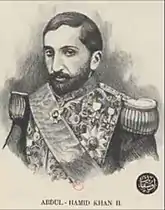
Abdul Hamid ascended to the throne following the deposition of his brother Murad on 31 August 1876.[1][14] At his accession, some commentators were impressed that he rode practically unattended to the Eyüp Sultan Mosque, where he was given the Sword of Osman. Most people expected Abdul Hamid II to support liberal movements, however, he acceded the throne in 1876 in a very difficult and critical period for the Empire. Economic and political turmoil, local wars in the Balkans, and the Russian-Ottoman war of 1877–78 threatened the existence of the Ottoman Empire. Abdul Hamid used these difficult war-filled times to recreate the absolutist regime and to dissolve the parliament, usurping all political power until his overthrow.
First Constitutional Era, 1876–1878
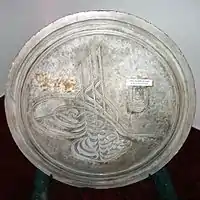
Abdul Hamid worked with the Young Ottomans to realize some form of constitutional arrangement.[15] This new form in its theoretical space could help to realize a liberal transition with Islamic arguments. The Young Ottomans believed that the modern parliamentary system was a restatement of the practice of consultation, or shura, which had existed in early Islam.[16]
On 23 December 1876, due to the 1875 insurrection in Bosnia and Herzegovina, the war with Serbia and Montenegro and the feeling aroused throughout Europe by the cruelty used in stamping out the Bulgarian rebellion, Abdul Hamid promulgated the constitution and its parliament.[1] The international Constantinople Conference[17][18] towards the end of 1876 was surprised by the promulgation of a constitution, but European powers at the conference rejected the constitution as a significant change; they preferred the 1856 constitution, the Hatt-ı Hümayun and 1839 Hatt-ı Şerif of Gülhane, but questioned whether there was need for a parliament to act as an official voice of the people.
In any event, like many other would-be reforms of the Ottoman Empire's change, it proved to be nearly impossible. Russia continued to mobilize for war. However, everything changed when a Royal Navy squadron approached the capital from the Sea of Marmara. Early in 1877 the Ottoman Empire went to war with the Russian Empire.
Disintegration
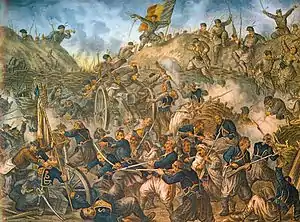
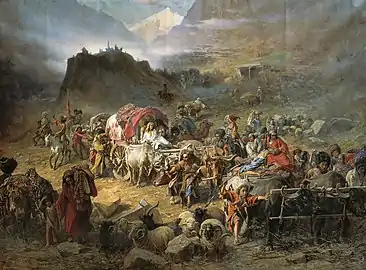
Abdul Hamid's biggest fear, near dissolution, was realized with the Russian declaration of war on 24 April 1877. In that conflict, the Ottoman Empire fought without help from European allies. Russian chancellor Prince Gorchakov had effectively purchased Austrian neutrality with the Reichstadt Agreement by that time. The British Empire, though still fearing the Russian threat to the British presence in India, did not involve itself in the conflict because of public opinion against the Ottomans, following reports of Ottoman brutality in putting down the Bulgarian uprising. The Russian victory was quickly realized; the conflict ended in February 1878. The Treaty of San Stefano, signed at the end of the war, imposed harsh terms: the Ottoman Empire gave independence to Romania, Serbia, and Montenegro; it granted autonomy to Bulgaria; instituted reforms in Bosnia and Herzegovina; and ceded parts of Dobrudzha to Romania and parts of Armenia to Russia, which was also paid an enormous indemnity. After the war with Russia, Abdul Hamid suspended the constitution in February 1878 and dismissed the parliament after its solitary meeting in March 1877. For the next three decades, the Ottoman Empire was ruled by Abdulhamid from Yıldız Palace.[1]
As Russia could dominate the newly independent states, the country's influence in South-eastern Europe was greatly increased by the Treaty of San Stefano. Due to the insistence of the Great Powers (especially the United Kingdom), the treaty was later revised at the Congress of Berlin so as to reduce the great advantages acquired by Russia. In exchange of these favors, Cyprus was ceded to Britain in 1878. There were troubles in Egypt, where a discredited khedive had to be deposed. Abdul Hamid mishandled relations with Urabi Pasha, and as a result Britain gained de facto control over Egypt and Sudan by sending its troops in 1882 to establish control over the two provinces. Cyprus, Egypt, and Sudan remained ostensibly Ottoman provinces until 1914 when Britain officially annexed those territories in response to the Ottoman participation in World War I on the side of the Central Powers.
There were key problems regarding the Albanian question resulting from the Albanian League of Prizren and with the Greek and Montenegrin frontiers where the European powers were determined that the decisions of the Berlin Congress should be carried into effect.
The union in 1885 of Bulgaria with Eastern Rumelia was another blow. The creation of an independent and powerful Bulgaria was viewed as a serious threat to the Ottoman Empire. For many years Abdul Hamid had to deal with Bulgaria in a way that did not antagonize either Russian or German wishes.
Crete was granted 'extended privileges', but these did not satisfy the population, which sought unification with Greece. In early 1897 a Greek expedition, sailed to Crete to overthrow Ottoman rule on the island. This act was followed by war, in which the Ottoman Empire defeated Greece (see the Greco-Turkish War (1897)); however as a result of the Treaty of Constantinople, Crete was taken over en depot by the United Kingdom, France, and Russia. Prince George of Greece was appointed as ruler and Crete was effectively lost to the Ottoman Empire.[1] The ʿAmmiyya, a revolt in 1889–90 among Druze and other Syrians against excesses of the local sheikhs, similarly led to capitulation to the rebels' demands, as well as concessions to Belgian and French companies to provide the area with rail service.
Armenian Question
Starting around 1890, Armenians began demanding the implementation of the reforms which were promised to them at the Berlin conference.[19] To prevent such measures, in 1890–91, Sultan Abdul Hamid gave semi-official status to the Kurdish bandits who were already actively mistreating the Armenians in the provinces. Made up of Kurds (as well as other ethnic groups such as Turcomans), and armed by the state, they came to be called the Hamidiye Alaylari ("Hamidian Regiments").[20] The Hamidiye and Kurdish brigands were given free rein to attack Armenians, confiscating stores of grain, foodstuffs, and driving off livestock, and confident of escaping punishment as they were subject only to court-martial.[21] In the face of such violence, the Armenians established revolutionary organizations, namely the Social Democrat Hunchakian Party (Hunchak; founded in Switzerland in 1887) and the Armenian Revolutionary Federation (the ARF or Dashnaktsutiun, founded in 1890 in Tiflis).[22] Clashes ensued and unrest occurred in 1892 at Merzifon and in 1893 at Tokat. Abdul Hamid II did not hesitate to put down these revolts with harsh methods while using the local Muslims (in most cases Kurds) against the Armenians.[23] As a result of such violence, 300,000 Armenians were killed in what became known as the Hamidian massacres. News of the Armenian massacres was widely reported in Europe and the United States and drew strong responses from foreign governments and humanitarian organizations alike.[24] Hence, Abdul Hamid II was referred to as the "Bloody Sultan" or "Red Sultan" in the West. On 21 July 1905, the Armenian Revolutionary Federation attempted to assassinate him with a car bombing during a public appearance, but the Sultan was delayed for a minute and the bomb went off too early, killing 26, wounding 58 (of which four died during their treatment in a hospital) and destroying 17 cars. This continued aggression, along with the handling of the Armenian desire for reforms, led to the western European powers taking a more hands-on approach with the Turks.[1]
America and the Philippines
Sultan Abdul Hamid II, after being approached by American minister to Turkey, Oscar Straus, sent a letter to the Moros the Sulu Sultanate telling them not to resist American takeover and to cooperate with the Americans at the start of the Moro Rebellion. The Sulu Moros complied with the order.
John Hay, the American Secretary of State, asked Straus in 1898 to approach Sultan Abdul Hamid II to request that the Sultan (who was also Caliph) write a letter to the Moro Sulu Muslims of the Sulu Sultanate in the Philippines telling them to submit to American suzerainty and American military rule. The Sultan obliged them and wrote the letter, which was sent to Sulu via Mecca where two Sulu chiefs brought it home to Sulu, and it was successful, since the "Sulu Mohammedans ... refused to join the insurrectionists and had placed themselves under the control of our army, thereby recognizing American sovereignty."[25] The Ottoman Sultan used his position as caliph to order the Sulu Sultan not to resist and not fight the Americans when they became subject to American control.[26] President McKinley did not mention Turkey's role in the pacification of the Sulu Moros in his address to the first session of the Fifty-sixth Congress in December 1899, since the agreement with the Sultan of Sulu was not submitted to the Senate until 18 December.[27] Despite Sultan Abdul Hamid's "pan-Islamic" ideology, he readily acceded to a request by Straus for help in telling the Sulu Muslims to not resist America since he felt no need to cause hostilities between the West and Muslims.[28] Collaboration between the American military and Sulu sultanate was due to the Sulu Sultan being persuaded by the Ottoman Sultan.[29] John P. Finley wrote that:
After due consideration of these facts, the Sultan, as Caliph caused a message to be sent to the Mohammedans of the Philippine Islands forbidding them to enter into any hostilities against the Americans, inasmuch as no interference with their religion would be allowed under American rule. As the Moros have never asked more than that, it is not surprising, that they refused all overtures made, by Aguinaldo's agents, at the time of the Filipino insurrection. President McKinley sent a personal letter of thanks to Mr. Straus for the excellent work he had done, and said, its accomplishment had saved the United States at least twenty thousand troops in the field.[30][31]
Abdulh Hamid in his position as Caliph was approached by the Americans to help them deal with Muslims during their war in the Philippines,[32] and the Muslim people of the area obeyed the order sent by Abdul Hamid to help the Americans.[33][34][35]
The Bates Treaty, which the Americans had signed with the Moro Sulu Sultanate and which guaranteed the Sultanate's autonomy in its internal affairs and governance, was then violated by the Americans, who then invaded Moroland,[36] causing the Moro Rebellion to break out in 1904 with war raging between the Americans and Moro Muslims and atrocities committed against Moro Muslim women and children, such as the Moro Crater Massacre.
Germany's support
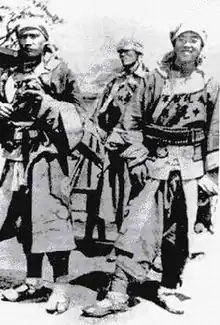
The Triple Entente – the United Kingdom, France and Russia – maintained strained relations with the Ottoman Empire. Abdul Hamid and his close advisors believed the Empire should be treated as an equal player by these great powers. In the Sultan's view, the Ottoman Empire was a European empire, distinct for having more Muslims than Christians.
Over time the hostile diplomatic attitudes shown from France (the occupation of Tunisia in 1881) and Great Britain (the 1882 establishment of de facto control in Egypt) caused Abdul Hamid to gravitate towards Germany.[1] Kaiser Wilhelm II was twice hosted by Abdul Hamid in Constantinople; first on 21 October 1889, and nine years later, on 5 October 1898. (Wilhelm II later visited Constantinople for a third time, on 15 October 1917, as a guest of Mehmed V). German officers (like Baron von der Goltz and Bodo-Borries von Ditfurth) were employed to oversee the organization of the Ottoman army.
German government officials were brought in to reorganize the Ottoman government's finances. Additionally, the German Emperor was rumored in counseling Hamid II in his controversial decision to appoint his third son as his successor.[37] Germany's friendship was not altruistic; it had to be fostered with railway and loan concessions. In 1899, a significant German desire, the construction of a Berlin-Baghdad railway, was granted.[1]
Kaiser Wilhelm II of Germany also requested the Sultan's help when having trouble with Chinese Muslim troops. During the Boxer Rebellion, the Chinese Muslim Kansu Braves fought against the German Army, routing them, along with the other Eight Nation Alliance forces. The Muslim Kansu Braves and Boxers defeated the Alliance forces led by the German Captain von Usedom at the Battle of Langfang in the Seymour Expedition in 1900 and besieged the trapped Alliance forces during the Siege of the International Legations. It was only on the second attempt in the Gasalee Expedition, that the Alliance forces managed to get through to battle the Chinese Muslim troops at the Battle of Peking. Kaiser Wilhelm was so alarmed by the Chinese Muslim troops that he requested that Abdul Hamid find a way to stop the Muslim troops from fighting. Abdul Hamid agreed to the Kaiser's demands and sent Enver Pasha to China in 1901, but the rebellion was over by that time.[38] Because the Ottomans did not want conflict against the European nations and because the Ottoman Empire was ingratiating itself to gain German assistance, an order imploring Chinese Muslims to avoid assisting the Boxers was issued by the Ottoman Khalifa and reprinted in Egyptian and Muslim Indian newspapers.[39]
Second Constitutional Era, 1908
-Opening_of_the_first_parlement.png.webp)
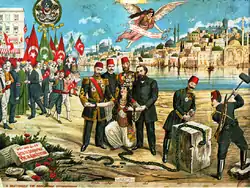
The national humiliation of the situation in Macedonia, together with the resentment in the army against the palace spies and informers, at last brought matters to a crisis.[40]
In the summer of 1908, the Young Turk Revolution broke out and Abdul Hamid, upon learning that the troops in Salonica were marching on Istanbul (23 July), at once capitulated. On 24 July an irade announced the restoration of the suspended constitution of 1876; the next day, further irades abolished espionage and censorship, and ordered the release of political prisoners.[40]
On 17 December, Abdul Hamid opened the Ottoman parliament with a speech from the throne in which he said that the first parliament had been "temporarily dissolved until the education of the people had been brought to a sufficiently high level by the extension of instruction throughout the empire."[40]
Countercoup, 1909
The new attitude of the sultan did not save him from the suspicion of intriguing with the powerful reactionary elements in the state, a suspicion confirmed by his attitude towards the counter-revolution of 13 April 1909 known as the 31 March Incident, when an insurrection of the soldiers backed by a conservative upheaval in some parts of the military in the capital overthrew the new Young Turks' cabinet. The government, restored by soldiers from Salonica, decided on Abdul Hamid's deposition, and on 27 April his brother Reshad Efendi was proclaimed as Sultan Mehmed V.[41]
The Sultan's countercoup, which had appealed to conservative Islamists against the Young Turks' liberal reforms, resulted in the massacre of tens of thousands of Christian Armenians in the Adana province.[42]
Deposition and aftermath
The ex-sultan was conveyed into captivity at Salonica (now known as Thessaloniki).[40] In 1912, when Salonica fell to Greece, he was returned to captivity in Constantinople. He spent his last days studying, practicing carpentry and writing his memoirs in custody at Beylerbeyi Palace in the Bosphorus, in the company of his wives and children, where he died on 10 February 1918, just a few months before his brother, Mehmed V, the Sultan. He was buried in Istanbul.
In 1930, his nine widows and thirteen children were granted $50 million U.S. dollars from his estate, following a lawsuit that lasted five years. His estate was worth US$1.5 billion.[43]
Abdul Hamid was the last Sultan of the Ottoman Empire to hold absolute power. He presided over 33 years of decline. The Ottoman Empire had long been acknowledged as the "sick man of Europe" by other European countries.
Ideology
Pan-Islamism
Abdul Hamid believed that the ideas of Tanzimat could not bring the disparate peoples of the empire to a common identity, such as Ottomanism. He adopted a new ideological principle, Pan-Islamism; since Ottoman sultans beginning with 1517 were also nominally Caliphs, he wanted to promote that fact and emphasized the Ottoman Caliphate. He saw the huge diversity of ethnicities in the Ottoman Empire and believed that Islam was the only way to unite his Muslim people.
He encouraged Pan-Islamism, telling Muslims living under European powers to unite into one polity. This threatened several European countries, namely Austria through Albanian Muslims, Russia through Tatars and Kurds, France through Moroccan Muslims, and Britain through Indian Muslims.[44] The privileges of foreigners in the Ottoman Empire, which were an obstacle to an effective government, were curtailed. At the very end of his reign, he finally provided funds to start construction of the strategically important Constantinople-Baghdad Railway and the Constantinople-Medina Railway, making the trip to Mecca for Hajj more efficient. After he was deposed, the construction of both railways was accelerated and completed by the Young Turks. Missionaries were sent to distant countries preaching Islam and the Caliph's supremacy.[40] During his rule, Abdul Hamid refused Theodor Herzl's offers to pay down a substantial portion of the Ottoman debt (150 million pounds sterling in gold) in exchange for a charter allowing the Zionists to settle in Palestine. He is famously quoted as telling Herzl's Emissary that "as long as I am alive, I will not have our body divided, only our corpse they can divide."[45]
Pan-Islamism was a considerable success. After the Greco-Ottoman war, many Muslims celebrated the victory and saw the Ottoman victory as Muslims' victory. Uprisings, lockouts, and objections against European colonization in newspapers were reported in Muslim regions after the war.[44][46] However, Abdul Hamid's appeals to Muslim sentiment were not always very effective due to widespread disaffection within the Empire. In Mesopotamia and Yemen disturbance was endemic; nearer home, a semblance of loyalty was maintained in the army and among the Muslim population only by a system of deflation and espionage.
Political decisions and reforms
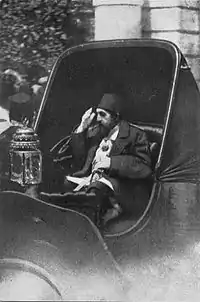
Most people expected Abdul Hamid II to have liberal ideas, and some conservatives were inclined to regard him with suspicion as a dangerous reformer.[41] However, despite working with the reformist Young Ottomans while still a crown prince and appearing as a liberal leader, he became increasingly conservative immediately after taking the throne as a reaction to several failed assassination attempts. Default in the public funds, an empty treasury, the 1875 insurrection in Bosnia and Herzegovina, the war with Serbia and Montenegro, the result of Ninety-Three War and the feeling aroused throughout Europe by the Abdul Hamid government in stamping out the Bulgarian rebellion all contributed to his apprehension for enacting significant changes.[41]
There were many further setbacks. Financial embarrassments forced him to consent to foreign control over the Ottoman national debt. In a decree issued in December 1881, a large portion of the empire's revenues were handed over to the Public Debt Administration for the benefit of (mostly foreign) bondholders.
Over the years, Abdul Hamid succeeded in reducing his ministers to the position of secretaries, and he concentrated much of the Empire's administration into his own hands at Yıldız Palace. However, internal dissension was not reduced. Crete was constantly in turmoil. The Greeks living within the Ottoman Empire's borders were dissatisfied, along with the Armenians.[41]
Abdul Hamid's distrust for the reformist admirals of the Ottoman Navy (whom he suspected of plotting against him and trying to bring back the 1876 constitution) and his subsequent decision to lock the Ottoman fleet (which ranked as the 3rd largest fleet in the world during the reign of his predecessor Abdülaziz) inside the Golden Horn caused the loss of Ottoman overseas territories and islands in North Africa, the Mediterranean Sea, and the Aegean Sea during and after his reign.[47]
His push for education resulted in the establishment of 18 professional schools, and in 1900, Darulfunun, now known as Istanbul University, was established.[1] He also created a large system of secondary, primary, and military schools throughout the empire.[1] 51 secondary schools were constructed in a 12-year period (1882–1894). As the goal of the educational reforms in the Hamidian era were to counter foreign influence, these secondary schools utilized European teaching techniques, yet instilled within students a strong sense of Ottoman identity, Islamic morality.[48]
Abdul Hamid also reorganized the Ministry of Justice and developed rail and telegraph systems.[1] The telegraph system expanded to incorporate the furthest parts of the Empire. Railways connected Constantinople and Vienna by 1883, and shortly afterward the Orient Express connected Paris to Constantinople. During his rule, railways within the Ottoman Empire expanded to connect Ottoman-controlled Europe and Anatolia with Constantinople as well. The increased ability to travel and communicate within the Ottoman Empire served to strengthen Constantinople's influence over the rest of the Empire.[48]
Security measures
Abdul Hamid took tight measures for his security. The memory of the deposition of Abdülaziz was on his mind and convinced him that a constitutional government was not a good idea. Because of this, information was tightly controlled and the press was tightly censored. The curriculum of schools was subject to close inspection to prevent dissidence. Ironically, the schools that Abdul Hamid founded and tried to control became "breeding grounds of discontent" as students and teachers alike chafed at the clumsy restrictions of the censors.[49]
Photographs of the Ottoman Empire
Threatened by several assassination attempts, Abdul Hamid II did not travel often (though still more than many previous rulers). Photographs provided visual evidence of what was taking place in his realm. He commissioned thousands of photographs of his empire including from the Constantinople studio of Jean Pascal Sébah. The Sultan presented large gift albums of photographs to various governments and heads of state, including the United States[50] and Great Britain.[51] The American collection is housed in the Library of Congress and has been digitized.[52]
In popular culture
Abdul the Damned (1935) portrays a time near the end of the sultan's life.
Payitaht Abdulhamid, named 'The Last Emperor' in English, is a Turkish historical television drama series depicting the last 13 years of the reign of Abdul Hamid II.
Personal life

Abdul Hamid II was born at Çırağan Palace, Ortaköy, or at Topkapı Palace, both in Istanbul, the son of Sultan Abdulmejid I and one of his many wives, Tîr-î-Müjgan Sultan, (Circassia, 16 August 1819 – Constantinople, Feriye Palace, 2 November 1853).[53][54] He later also became the adoptive son of another of his father's wives, Valide Sultan Rahime Perestu. He was a skilled carpenter and personally crafted most of his own furniture, which can be seen today at the Yıldız Palace and Beylerbeyi Palace in Constantinople. Abdul Hamid II was also interested in opera and personally wrote the first-ever Turkish translations of many opera classics. He also composed several opera pieces for the Mızıka-ı Hümayun which he established, and hosted the famous performers of Europe at the Opera House of Yıldız Palace which was recently restored and featured in the film Harem Suare (1999). He was also a fan of the actress Sarah Bernhardt, and he brought her to his private theatre on numerous occasions.[55]
In the opinion of F. A. K. Yasamee:[56]
He was a striking amalgam of determination and timidity, of insight and fantasy, held together by immense practical caution and an instinct for the fundamentals of power. He was frequently underestimated. Judged on his record, he was a formidable domestic politician and an effective diplomat.[57]
He was also a good wrestler of Yağlı güreş and a 'patron saint' of the wrestlers. He organized wrestling tournaments in the empire and selected wrestlers were invited to the palace. Abdul Hamid personally tried the sportsmen and good ones remained in the palace.
Religion
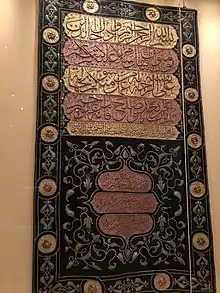
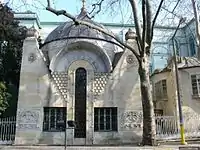
Sultan Abdul Hamid II was a practitioner of traditional Islamic spirituality. He was influenced by Libyan Shadhili Madani Sheikh, Muhammad Zafir al-Madani whose lessons he would attend in disguise in Unkapani before he became Sultan. Abdul Hamid II asked Sheikh al-Madani to return to Istanbul after he ascended the throne. The sheik initiated Shadhili gatherings of remembrance (dhikr) in the newly commissioned Yıldız Hamidiye Mosque; on Thursday evenings he would accompany Sufi masters in reciting dhikr.[55] He also became a close religious and political confidant of the Sultan. In 1879 the Sultan excused the taxes of all of the Caliphate's Madani Sufi lodges (also known as zawiyas and tekkes). In 1888, he even established a Sufi lodge for the Madani order of Shadhili Sufism in Istanbul, which he commissioned as part of the Ertuğrul Tekke mosque. The relationship of the Sultan and the sheik lasted for thirty years until the latter's death in 1903.[59]
Poetry
Abdul Hamid wrote poetry, following on the footsteps of many other Ottoman sultans. One of his poems translates thus:
My Lord I know you are the Dear One (Al-Aziz)
... And no one but you are the Dear One
You are the One, and nothing else
My God take my hand in these hard timesMy God be my helper in this critical hour
He was extremely fond of Sherlock Holmes novels.[61]
Marriages and descendants
Officially, Abdul Hamid II had only four legal wives and many additional concubines (of which eight were his favourites), but he is falsely ascribed as having twelve wives.[62][63][64][65]
First marriage and descendant
He was first married to Abkhazian Nazikeda Kadın (c. 1850 – Yıldız Palace, Constantinople, 11 April 1895) at the Dolmabahçe Palace in Istanbul in 1863. Abkhazian Nazikeda Kadin was the daughter of Prince Arzakan Bey Tsanba and his wife Princess Esma Klıç.[65] Together, they had one daughter:
- Ulviye Sultan (1868 – 5 October 1875)
Second marriage and descendants
Following his first marriage, Abdul Hamid II was married to Natukhai Bedrifelek Kadın.[65] Abdul Hamid II's descendants with Natukhai Bedrifelek Kadin by their three children include:
- Şehzade Mehmed Selim (11 January 1870 – 4 May 1937), married at Constantinople, Yıldız Palace, on 4 June 1886 to Abkhazian Eryale Hanım (10 February 1870 – 27 December 1904), daughter of Prince Ali Hasan Bey Marshania and his wife Princess Fatma Horecan Aredba, and had a son and a daughter, married secondly at Constantinople, Yıldız Palace, Eflakyar Hanım, (Batumi, Georgia, ? – Beirut, 1930), daughter of Gazi Muhammed Bey, without issue, married thirdly Constantinople, Yıldız Palace, on 30 June 1905 to Nilüfer Hanım (Artvin, 1 May 1887 – 23 August 1943) married fourthly at Constantinople, Yıldız Palace, on 29 March 1910 to his relative Pervin Dürrüyekta Hanım (Adapazarı, 6 June 1894 – Lebanon, 1969 and buried there), daughter of Prince Kerzedzh Zekeriya Bey by his wife Şadiye Hanım, married fifthly at Constantinople, Yıldız Palace to Gülnaz Hanım (? – ?), without issue, married sixthly at Sivas on 16 September 1918 to Dilistan Leman Hanım (? – Beirut, Lebanon, 1 February 1951 and buried there), daughter of Osman Bey, an Abkhazian, by his wife Mevlüde Hanım, without issue:
- Şehzade Mehmed (26 April 1887 – 1890)
- Emine Nemika Sultan (Constantinople, Yıldız Palace, 9 March 1888 – Istanbul, 6 September 1969), married and have issue
- Şehzade Abdülkerim (Constantinople, Yıldız Palace, 26 June 1906 – New York City, 3 August 1935), married at Aleppo on 24 February 1930 and divorced in 1931 Nimet Hanım (Damascus, 25 December 1911 – Damascus, 4 August 1981), and had two sons:
- Dündar Ali Osman Osmanoğlu (born Damascus, 30 December 1930 ,2021 – Damascus,), married to Yüsra Hanım (born 1927), without issue
- Şehzade Harun Osmanoğlu (born Damascus, 10 February 1932), married to Farizet Darvich Hanım (born 1947), and had:
- Şehzade Orhan Osmanoğlu (born Damascus, 25 August 1963), married on 22 December 1985 to Nuran Yıldız Hanım (born 1967), and had one son and four daughters:
- Nilhan Osmanoğlu Sultan (born Istanbul, 25 April 1987), married in Istanbul on 22 September 2012 Damat Mehmet Behlül Vatansever and had issue:
- Hanzade Vatansever Hanımsultan (born 2013)
- Sultanzade Vahdettin Vatansever Bey (born 2014)
- Şehzade Yavuz Selim Osmanoğlu (born Istanbul, 22 February 1989)
- Nilüfer Osmanoğlu Sultan (born Istanbul, 5 May 1995)
- Berna Osmanoğlu Sultan (born Istanbul, 1 October 1998)
- Asyahan Osmanoğlu Sultan (born Istanbul, ... ... 2004)
- Nilhan Osmanoğlu Sultan (born Istanbul, 25 April 1987), married in Istanbul on 22 September 2012 Damat Mehmet Behlül Vatansever and had issue:
- Nurhan Osmanoğlu Sultan (born Damascus, 20 November 1973), married firstly in Istanbul on 15 April 1994 and later divorced Damat Samir Hashem Bey (born 24 January 1959), without issue, and married secondly to Damat Muhammed Ammar Sagherji Bey (born 1972), and had one son and one daughter:
- Sultanzade Muhammed Halil Sagherji Bey (born 2002)
- Sara Sagherji Hanımsultan (born 2004)
- Şehzade Abdulhamid Kayıhan Osmanoğlu (born 4 August 1979)
- Şehzade Muhammed Harun Osmanoğlu (born 2007)
- Şehzade Abdülaziz Osmanoğlu (2016)
- Şehzade Orhan Osmanoğlu (born Damascus, 25 August 1963), married on 22 December 1985 to Nuran Yıldız Hanım (born 1967), and had one son and four daughters:
- Zekiye Sultan (Dolmabahçe Palace, 21 January 1872 – Pau, 13 July 1950 and buried there), married at Constantinople, Yıldız Palace, on 20 April 1889 to Damat Ali Nureddin Pasha Bey (1867–1953), created Damat in 1889, and had issue:
- Ulviye Shükriye Hanımsultan (1890 – 23 February 1893)
- Fatima Aliye Hanımsultan (1891 – Constantinople, 14 April 1972), married in 1911 Mehmed Muhsin Yegen and got issue:
- Osman Yegen (1913–1988) married Yvonne Rosenberg, without issue
- Salih Yegen (1921–1994) married Ülkü Becan with issue:
- Fatma Yasemin Yegen (born 1973) married Hakan Baris
- Muhsin Osman Yegen (born 1977)
- Şehzade Ahmed Nuri (Istanbul, Yıldız Palace, 11 February 1878 – Nice, August 1944), married at Constantinople, Yıldız Palace, in 1900 to Fahriye Zişan Hanım (Constantinople, 1883 – Nice, France, 1940 and buried in Sultan Selim Mosque, Damascus), daughter of Ali Ilyas Bey, a Circassian lieutenant colonel in the Imperial Ottoman Army, without issue, without issue;
Third marriage
His third marriage to Circassian Nurefsun Kadın (c. 1851 – 1908), which ended in divorce in 1881, without issue. Nurefsun was a lady formerly in the household of Khedive Isma'il Pasha and Sultan Abdulaziz.[66]
Fourth marriage and descendants
His fourth marriage was to Kabardian Bidar Kadın (Caucasus, 5 May 1858 – Erenköy, Asia Minor, 1 January 1918), daughter of Prince Ibrahim Bey Talustan by his wife Princess Şahika İffet Hanım Lortkipanidze, at Constantinople, Yıldız Palace, on 2 September 1875. Together, they had two children:
- Naime Sultan (Constantinople, Yıldız Palace, 3 September 1875 – Tirana, 1945), married at Istanbul, Ortaköy, Ortaköy Palace, on 17 March 1898 and divorced in 1904 Damat Mehmed Kemaleddin Pasha Bey (1869–1920), created Damat in 1898, title removed on his divorce in 1904, married secondly on 11 July 1907 Mahmud Celaleddin (1874–1944), and had:
- Beyzade Mehmed Cahid Osman Bey (Constantinople, Ortaköy, Ortaköy Palace, January 1899 – Istanbul, 30 March 1977 and buried there), married firstly in January 1922 to his cousin Dürriye Sultan (Constantinople, Dolmabahçe Palace, 3 August 1905 – Halki, 15 July 1922), without issue, and married secondly to Levrens Hadjer Hussein Hanım, and had issue:
- Bulent Osman Bey (born Nice, 2 May 1930), married at Libreville on 8 November 1962 to French Jeannine Crété, and had issue:
- Rémy Gengiz Ossmann (born 1963), married on 16 November 19?? to Florence Weber, and had issue:
- Sélim Ossmann (born 1993)
- Rémy Gengiz Ossmann (born 1963), married on 16 November 19?? to Florence Weber, and had issue:
- Bulent Osman Bey (born Nice, 2 May 1930), married at Libreville on 8 November 1962 to French Jeannine Crété, and had issue:
- Adile Hanım Sultan (Constantinople, Ortaköy, Ortaköy Palace, 12 November 1900 – February 1979), married at Üsküdar on 4 May 1922 and divorced in 1928 her cousin Şehzade Mahmud Sevket (Constantinople, Ortaköy, Ortaköy Palace, 20 July 1903 – 1 February 1973), excluded from the Imperial House in 1931
- Emine Hanım Sultan (Constantinople, Ortaköy, Ortaköy Palace, 1911 -2000, married and had issue
- Beyzade Mehmed Cahid Osman Bey (Constantinople, Ortaköy, Ortaköy Palace, January 1899 – Istanbul, 30 March 1977 and buried there), married firstly in January 1922 to his cousin Dürriye Sultan (Constantinople, Dolmabahçe Palace, 3 August 1905 – Halki, 15 July 1922), without issue, and married secondly to Levrens Hadjer Hussein Hanım, and had issue:
- Şehzade Mehmed Abdülkadir (Constantinople, Beşiktaş, Dolmabahçe Palace, 16 January 1878 – Sofia, January or 16 March 1944 and buried there), Captain of the Ottoman Army, married firstly in Constantinople, Yıldız Palace, in 1898, to Mislimelek Hanım, née Pakize Marşania, daughter of Prince Abdülkadir Bey Maşan by his wife Princess Mevlüde Hanım İnalipa, married secondly in Constantinople, Yıldız Palace, and divorced, to Sühendan Hanım (Tokat, ? – ?), married thirdly at Constantinople, Yıldız Palace, on 6 June 1907 to Mihriban Hanım (Constantinople, 18 May 1890 – Cairo, 1956) and had one son, married fourthly in Kızıltoprak, Asia Minor, on 1 June 1913 and divorced in 1934 to Hadice Macide Hanım (Adapazarı, 14 September 1899 – Vienna, 1934 and buried there), daughter of Mustafa Şerif Bey, Colonel in the Imperial Ottoman Army, and had one son, married fifthly at Kızıltoprak, Asia Minor, on 5 February 1916 to Meziyet Fatma Hanım (İzmit, 17 February 1902 – Istanbul, 13 November 1989), daughter of Mecid Bey, Colonel in the Imperial Ottoman Army, and had one son and two daughters, and married sixthly in Budapest on 4 July 1924 to Irene Mer Hanım, and had one son:
- Mehmed Orhan II
- Şehzade Ertuğrul Necib Ali (Kızıltoprak, Asia Minor, 15 March 1915 – Vienna, 7 February 1994), married in Vienna on 14 August 1946 to Austrian Gertrude Emilia Tengler Hanım (Vienna, born 25 May 1926), and had issue:
- Margot Leyla Kadir Sultan (born Vienna, 17 June 1947), married to Austrian Damat Werner Schnelle Bey (born 1942), and had one daughter:
- Katharina Alia Schnelle Hanımsultan (born 1980)
- Şehzade Roland Selim Kadir (born Vienna, 5 May 1949), married in Salzburg in 1972 to Gerlinde ... Hanım (born 1946), and had issue:
- Şehzade René Osman Abdul Kadir (born Salzburg, 23 August 1975)
- Şehzade Daniel Adrian Hamid Kadir (born 20 September 1977)
- Margot Leyla Kadir Sultan (born Vienna, 17 June 1947), married to Austrian Damat Werner Schnelle Bey (born 1942), and had one daughter:
- Şehzade Alaeddin Kadir (Kızıltoprak, Asia Minor, 2 January 1917 – Sofia, 26 November 1999), Titular Crown Prince of Turkey from 1994 to 1999, married to Lydia Dimitrova Hanım, and had issue:
- Iskra Sultan (born Sofia, 1949), married to Austrian Damat Joachim (Peter) Schlang Bey (born 1940), and had one daughter:
- Princess Andrea Schlang Hanımsultan (born 1974), married to Austrian Thomas Schüttfort (born 1972), and had one son:
- Niklas Peter Schüttfort (born 1999)
- Princess Andrea Schlang Hanımsultan (born 1974), married to Austrian Thomas Schüttfort (born 1972), and had one son:
- Şehzade Plamen (Sofia, 1960 – Sofia, 1995)
- Iskra Sultan (born Sofia, 1949), married to Austrian Damat Joachim (Peter) Schlang Bey (born 1940), and had one daughter:
- Biydâr Sultan (Kızıltoprak, Asia Minor, 3 January 1924 – Budapest, August 1924 and buried there)
- Safvet Neslişah Sultan (born Budapest, 25 December 1925), married to Damat ... Reda Bey, and had two sons:
- Sultanzade Salih Reda Bey (born 1955), unmarried and without issue.
- Sultanzade Ömer Reda Bey (born 1959), married to Ceylan Fethiye Palay (born 1971), and had two daughters:
- Meziyet Dilara Reda Hanım (born 1998)
- Neslişah Reda Hanım (born 2000)
- Şehzade Osman (Budapest, 1925 – Budapest, 1934)
Fifth marriage and descendant
His fifth marriage was in Constantinople, Yıldız Palace, on 10 April 1883 to Georgian Dilpesend Kadın (Tbilisi, 16 January 1865 – Constantinople, Yıldız Palace, 5 October 1903), adoptive daughter of Tiryal Hanım, wife of Sultan Mahmud II, and had one daughter:
- Naile Sultan (Constantinople, Yıldız Palace, 9 January 1884 – Erenköy, Asia Minor, 25 October 1957), married at the Kuruceşme Palace, 27 February 1905, to Damat Arif Hikmet Pasha Germiyanoglu (Prizrin, 16 December 1872 – Beirut, 23 April 1942), sometime Senator and minister for justice, third son of Haji Abdurrahman Nureddin Pasha, sometime Grand Vizier, without issue.
Sixth marriage and descendants
His sixth marriage was at Constantinople, Yıldız Palace, on 2 January 1885 to Abkhazian Mezide Mestan Kadın (Ganja, 3 March 1869 – Constantinople, Yıldız Palace, 21 January 1909), daughter of Kaymat Bey Mikanba by his wife Princess Feryal Hanım Marşania,[65] and had one son:
- Şehzade Mehmed Burhaneddin (Constantinople, Yıldız Palace, 19 December 1885 – New York City, 15 June 1949 and buried in Damascus), Captain of the Ottoman Army, Titular King of Albania in 1914, married firstly in 1908 Hidayet Hanım, alias Nurbanu, née Emine Açba, daughter of Prince Mehmed Refik Bey Açba by his wife Princess Emine Mahşeref Hanım Emuhvari, and had a son, married secondly at Nişantaşı Palace, Pera (today Beyoğlu), on 7 June 1909 and divorced in 1919 Aliyemelek Nazlıyar Hanım (Adapazarı, 13 October 1892 – Ankara, 31 August 1976), daughter of Huseyin Bey, educated at Theresian Military Academy, Vienna, and École des Sciences Politiques, Paris, and had a son, married thirdly in Paris on 29 April 1925 and divorced in 1925 Dutch Georgina Leonora Barnard Mosselmans (Bergen op Zoom, 23 August 1900 – 1969), daughter of Richard Frederick Hendrik Mosselmans and wife (who married secondly on 1 March 1926 to Fernand Comte Bertier de Sauvigny and thirdly on 18 August 1933 to Lord Sholto George Douglas (7 June 1872 – 6 April 1942), former husband of Loretta Mooney and son of the 9th Marquess of Queensberry), and married fourthly in London, Middlesex, on 3 July 1933 to Elsie Deming Jackson (New York City, 6 September 1879 – New York City, 12 May 1952):
- Şehzade Mehmed Fahreddin (Nişantaşı, Nişantaşı Palace, Pera (today Beyoğlu), 26 November 1911 – New York City, 13 July 1968), who married in Paris on 31 August 1933 Greek Catherine Papadopoulos Hanım (Paris, 20 May 1914 – Athens, 15 June 1945), marriage not recognized by the Imperial House, without issue
- Ertuğrul II Osman V
Seventh marriage and descendants
His seveneth marriage was at Constantinople, Yıldız Palace, 20 November 1885 to Abkhazian Emsalinur Kadın (Tbilisi, 2 January 1866 – Nişantaşı, 1950, buried in Yahya Efendi Mosque), daughter of Ömer Bey Kaya by his wife Selime Hanım, and had one daughter:
- Şadiye Sultan (Istanbul, Yıldız Palace, 30 November 1886 – 20 November 1977), married firstly at Constantinople, Nishantashi Palace on 3 December 1910, to Damat Fahir Bey (1882 – 27 September 1922, Constantinople, Nishantashi Palace), and had one daughter, married secondly in Paris, France, on 28 October 1931 to Damat Reshad Halis (1885, Constantinople – died ? November 1944, Paris) without issue:
- Samiye Hanımsultan Fahir (1918 in Constantinople, Nishantashi Palace – 20 Nov. 1992), married Larry D'arodaca, without issue
Eighth marriage and descendants
His eighth marriage was at Constantinople, Yıldız Palace, 12 January 1886 to Abkhazian at Constantinople Müşfika Kadın (Hopa, Caucasus, 10 December 1867 – Istanbul, 16 July 1961), daughter of Gazi Şehid Mahmud Bey Ağır by his wife Emine Hanım,[65] and had one daughter:
- Ayşe Sultan (Constantinople, Yıldız Palace, 31 October 1887 – 11 August 1960), married at Nişantaşı, Nişantaşı Palace, Pera (today Beyoğlu), on 3 April 1921 to Damat Mushir Mehmed Ali Rauf Nami Pashazade Bey (Istanbul, 1877 – Viroflay, Yvelines, 21 September 1937 and buried in Paris at Bobigny cemetery), and had issue:
- Sultanzade Ömer Nami Osmanoğlu Bey (1911 – ?), unmarried and without issue
- Sultanzade Osman Nami Osmanoğlu Bey (1918–2010), married firstly to Adile Tanyeri (?–1958), and had three daughter, and married secondly to German Müşfika Rothraud Granzow (born 1934), and had two daughters:
- Mediha Şükriye Nami Hanım (born 1947), unmarried and without issue
- Fethiye Nimet Nami Bey (born 1953), unmarried and without issue
- Ayşe Adile Nami Hanım (born 1958), married and had issue
- Gül Nur Dorothee Nami Hanım (born 1960), married and without issue
- Sofia Ayten Nami Hanım (born 1961), married Erman Kunter and had issue
- Roksan Kunter (born 1985)
- Beyzade Sultanzade Abdülhamid Rauf Osmanoğlu Bey (October 1921/1922 – 11 March 1981), unmarried and without issue
Ninth marriage and descendants
His ninth marriage was at Constantinople, Yıldız Palace, 31 August 1890 to Abkhazian Sazkar Hanım (İstinye, Istanbul, 8 May 1873 – Beirut, 1945), née Zekiye Maan, daughter of Bata Recep Abdullah Bey Maan by his wife Rukiye Havva Hanım Mikanba,[65] and had one daughter:
- Refia Sultan (Istanbul, Yıldız Palace, 15 June 1891 – Beirut, 1938; Beirut, Lebanon, buried in Damascus [Sultan Selim Mosque], Syria), married 3 September 1910 in Kiziltoprak Sarayi to Ali Fuad Bey, son of Ahmet Eyüb Pasha.
- Rebia Hanımsultan Eyüb (13 July 1911 in Kiziltoprak Sarayi – 19 June 1988, buried in Mahmud II Mausoleum), unmarried and without issue
- Ayşe Hamide Hanımsultan Eyüb (1918 in Kiziltoprak Sarayi – 1934 in Nice, France, buried in Damascus, Sultan Selim Mosque, Syria)
Tenth marriage and descendants
His tenth marriage was at Constantinople, Yıldız Palace, on 24 January 1893 to Abkhazian Peyveste Hanım (Caucasus, 10 May 1873 – Paris, 1944 and buried there at Bobigny Cemetery), née Rabia Emuhvari, daughter of Prince Osman Bey Emuhvari by his wife Princess Hesna Hanım Çaabalurhva,[65] and had one son:
- Şehzade Abdurrahim Hayri (Constantinople, Yıldız Palace, 14 August 1894 – Paris, 1 June 1952), married firstly at Nişantaşı Palace, Pera (today Beyoğlu), on 4 June 1919 and divorced in 1923 Nabila Emine Halim Hanım (Constantinople, 1 June 1899 – Istanbul, 6 December 1979), daughter of Prince Mehmed Abbas Halim Pasha, by his wife Princess Fahrünnisa Hatice Hanım, second daughter of Mehmed Tewfik Pasha, Khedive of Egypt, and had one daughter, married secondly at Constantinople to Misalruh Hanım (? – c. 1955, Nice, France, buried in Muslim Bobigny cemetery), alias Mihrişah, née Feride, daughter of Mehmed Bey by his wife Emine Hanım, without issue:
- Mihrishah Selcuk Sultan (Istanbul, 14 April 1920 – Monte Carlo, Monaco, 11 May 1980 and buried in Cairo), married firstly on 7 October 1940 to Damat Ahmed el-Djezuly Ratib Bey (Alexandria – 1972), and had issue, and married secondly in Cairo on 7 April 1966 to Ismail Assem, without issue:
- Hatice Türkân Ratib Hanımsultan (born Cairo, 1941), married to Hüseyin Fehmi (1941–2000), and had two daughters:
- Melek Fehmi (born 1966), three sons, Ahmed Ragab (born 1987), Abdelrahman Ragab (born 1991), Aly Ragab (born 1996).
- Nesrin Fehmi (born 1968), married to Mohamed El Naggar (born 1963). 2 sons, Amr El Naggar (born 1989), Sherif El Naggar (born 1992).
- Mihrimah Ratib Hanımsultan (Cairo, 1943 – Cairo, 1946 and buried there)
- Sultanzade Beyzade Touran Ibrahim Ratib Bey (born Giza, 3 May 1950), married in Bogotá on 27 July 1974 to French Noblewoman Anne Marguerite Marie de Montozon de Leguilhac (born Toulouse, 13 January 1947), and had issue:
- Fatıma Nimet Selçuk Mahiveş Ratib Hanım (born Rio de Janeiro, Rio de Janeiro, 11 July 1976)
- Karim El-Djezouly Ratib Bey (born Bogotá, 13 December 1978)
- Hatice Türkân Ratib Hanımsultan (born Cairo, 1941), married to Hüseyin Fehmi (1941–2000), and had two daughters:
- Mihrishah Selcuk Sultan (Istanbul, 14 April 1920 – Monte Carlo, Monaco, 11 May 1980 and buried in Cairo), married firstly on 7 October 1940 to Damat Ahmed el-Djezuly Ratib Bey (Alexandria – 1972), and had issue, and married secondly in Cairo on 7 April 1966 to Ismail Assem, without issue:
Eleventh marriage and descendants
His eleventh marriage was at Constantinople, Yıldız Palace on 20 July 1896 to Abkhazian Fatma Pesend Hanım (Constantinople, Ottoman Empire, 13 February 1876 – 5 November 1924), née Fatma Kadriye Achba, daughter of Prince Ahmed Sami Achba, member of an Abkhazian princely family by his wife, Fatıma Hanım Mamleeva, and had one daughter:
- Hatice Sultan (Constantinople, Yıldız Palace, 10 July 1897 – 14 February 1898)
Twelfth marriage and descendants
His twelfth marriage was at Constantinople, Yıldız Palace, on 10 May 1900 to Abkhazian Behice Hanım (Batumi, Georgia, 10 October 1882 – 22 October 1969), née Behiye Maan, daughter of Albus Bey Maan an Abkhazian leader by his wife Nazli Hanım Kucba,[65] and had two sons:
- Şehzade Ahmed Nureddin (Constantinople, Yıldız Palace, 12 June 1900 – 2 June 1945, buried at the Islamic cemetery of Bobigny near Paris), married at Maslak, Bosphorus, on 5 May 1919 to Ayşe Andelib Hanım (Adapazarı, 8 August 1902 – ?), daughter of Hüsnü Paşa, Aide-de-camp to Sultan Abdul Hamid II, by his wife Kudsiye Hanım, without issue
- Şehzade Mehmed Bedreddin (Istanbul, Yıldız Palace, 22 June 1901 – 13 October 1903)
Thirteenth marriage and descendants
His thirteenth marriage was at Constantinople, Yıldız Palace, on 4 November 1904 to Abkhazian Saliha Naciye Hanım (Batumi, Georgia, 1887 – Erenköy, Asia Minor, 4 December 1923), alias Saliha, née Zeliha Ankuap, daughter of Arslan Bey Ankuap by his wife Canhız Hanım,[65] and had two children:
- Şehzade Mehmed Abid (Constantinople, Yıldız Palace, 17 September 1905 – Beirut, 8 December 1973 and buried in Damascus), married firstly to Pınardil Fahriye Hanım (? – c. 1934 Nice, France, buried in Muslim Bobigny Cemetery), without issue, married secondly in Tirana on 12 January 1936 and divorced in 1949 Princess Senije Zogu (Mati, 15 November 1908 – Cannes, 15 April 1969), sister of King Zog I, without issue.
- Samiye Sultan (16 January 1908 – Constantinople, Yıldız Palace, 24 January 1909)
Awards and honours
- Ottoman orders
 Grand Master of the Order of the Crescent
Grand Master of the Order of the Crescent_-_ribbon_bar.png.webp) Grand Master of the Order of Glory
Grand Master of the Order of Glory Grand Master of the Order of the Medjidie
Grand Master of the Order of the Medjidie Grand Master of the Order of Osmanieh
Grand Master of the Order of Osmanieh
- Foreign orders and decorations
 Grand Cross of St. Stephen, 1881 (Austria-Hungary)[67]
Grand Cross of St. Stephen, 1881 (Austria-Hungary)[67] Knight of the Elephant, 13 December 1884 (Denmark)[68]
Knight of the Elephant, 13 December 1884 (Denmark)[68] Knight of the Seraphim, 24 July 1879 (Sweden-Norway)[69]
Knight of the Seraphim, 24 July 1879 (Sweden-Norway)[69] Grand Cross of the Order of Kamehameha I, July 1881 (Kingdom of Hawaii)[70]
Grand Cross of the Order of Kamehameha I, July 1881 (Kingdom of Hawaii)[70] Knight Grand Cross of the Order of Saint Olav, 11 February 1885 (Sweden-Norway)[71]
Knight Grand Cross of the Order of Saint Olav, 11 February 1885 (Sweden-Norway)[71] Grand Cross of the Tower and Sword (Kingdom of Portugal)
Grand Cross of the Tower and Sword (Kingdom of Portugal) Knight of the Golden Fleece, 19 December 1880 (Spain)[72]
Knight of the Golden Fleece, 19 December 1880 (Spain)[72] Grand Cross of the White Falcon, 1891 (Grand Duchy of Saxe-Weimar-Eisenach)[73]
Grand Cross of the White Falcon, 1891 (Grand Duchy of Saxe-Weimar-Eisenach)[73] Knight Grand Cross with Collar of the Order of Saint Alexander, 1897 (Principality of Bulgaria)[74]
Knight Grand Cross with Collar of the Order of Saint Alexander, 1897 (Principality of Bulgaria)[74] Knight Grand Cross with Collar of the Order of Carol I, 1907 (Kingdom of Romania)[75]
Knight Grand Cross with Collar of the Order of Carol I, 1907 (Kingdom of Romania)[75] Knight of the Annunciation, 29 November 1881 (Kingdom of Italy)[76]
Knight of the Annunciation, 29 November 1881 (Kingdom of Italy)[76] Knight of the Black Eagle (German Empire)[77]
Knight of the Black Eagle (German Empire)[77]_ribbon.svg.png.webp) Knight of the Order of the Royal House of Chakri, 18 December 1892 (Siam)[78]
Knight of the Order of the Royal House of Chakri, 18 December 1892 (Siam)[78] Knight Grand Cordon of the Order of the Chrysanthemum, 26 June 1888 (Empire of Japan)[79]
Knight Grand Cordon of the Order of the Chrysanthemum, 26 June 1888 (Empire of Japan)[79]
Gallery

 Abdul Hamid II, 1908 (L'Illustration)
Abdul Hamid II, 1908 (L'Illustration) Enver Bey, Sultan Abdul Hamid II and Niyazi Bey
Enver Bey, Sultan Abdul Hamid II and Niyazi Bey Abdul Hamid II arrives in Thessaloniki
Abdul Hamid II arrives in Thessaloniki Istanbul Military Museum Abdulhamid II desk
Istanbul Military Museum Abdulhamid II desk
See also
References
- Hoiberg, Dale H., ed. (2010). "Abdulhamid II". Encyclopedia Britannica. I: A-ak Bayes (15th ed.). Chicago, IL: Encyclopedia Britannica Inc. pp. 22. ISBN 978-1-59339-837-8.
- Some sources state that his birth date was on 22 September.
- Overy, Richard pp. 252, 253 (2010)
- "Abdulhamid II | biography – Ottoman sultan". Retrieved 29 September 2015.
-
- "Sultan beaten, capital falls, 6,000 are slain". The New York Times. 25 April 1909. Retrieved 16 August 2019.
- Vahan Hamamdjian (2004). Vahan's Triumph: Autobiography of an Adolescent Survivor of the Armenian Genocide. iUniverse. p. 11. ISBN 978-0-595-29381-0.
- Sharkey, Heather J. (2017). "The Pivotal Era of Abdulhamid II, 1876–1909". A History of Muslims, Christians, and Jews in the Modern Middle East. Cambridge University Press. pp. 179–242. doi:10.1017/9781139028455.006. ISBN 9781139028455.
- Schmidt, Jan (2018). "Introduction". The Orientalist Karl Süssheim Meets the Young Turk Officer İsma'il Hakki Bey: Two Unexplored Sources from the Last Decade in the Reign of the Ottoman Sultan Abdulhamid II. BRILL. p. 2. ISBN 978-90-04-36617-6.
- Ihrig, Stefan (2014). "Prologue: Leaving "Enverland"". Atatürk in the Nazi Imagination. Harvard University Press. pp. 1–9. ISBN 978-0-674-36837-8. JSTOR j.ctt9qdt54.
- Devrim, Cemil (February 1964). "The Oldest Turkish Newspaper - Yeni Asir". Gazette (Leiden, Netherlands). 10 (1): 11–15. doi:10.1177/001654926401000103. S2CID 144092475.
- Who is Sultan Abdulhamid? Türkiye. Posted 2 February 2017.
- Necip Fazıl Kısakürek, Ulu Hakan (İkinci Abdülhamid Han)
- Ulu Hakan mı Kızıl Sultan mı? Osmanlı Tarihinin En Tartışmalı Padişahı: 2. Abdülhamid (Turkish) onedio. Published 27 September 2016
- Hasip Sarıgöz, Ulu Hakan (Turkish)
- Razmik Panossian (13 August 2013). The Armenians: From Kings and Priests to Merchants and Commissars. Columbia University Press. p. 165. ISBN 978-0-231-13926-7.
- Freely, John – Inside the Seraglio, published 1999, Chapter 15: On the Shores of the Bosphorus
- Brookes, Douglas Scott (2010). The Concubine, the Princess, and the Teacher: Voices from the Ottoman Harem. University of Texas Press. p. 134. ISBN 978-0-292-78335-5.
- "Sultan Abdülaziz – Avrupa Seyahati". blog.milliyet.com.tr.
- Chambers Biographical Dictionary, ISBN 0-550-18022-2, p. 3
- Davison, Roderique H. Reform in the Ottoman Empire. Princeton University Press, 1963
- Hourani, Albert. Arabic Thought in the Liberal Age, 1798–1939. Cambridge University Press, 1962, p. 68
- The Encyclopædia Britannica, Vol.7, Edited by Hugh Chisholm, (1911), 3; Constantinople, the capital of the Turkish Empire
- Britannica, Istanbul:When the Republic of Turkey was founded in 1923, the capital was moved to Ankara, and Constantinople was officially renamed Istanbul in 1930.
- "Curios Information about Armenia". Armenica.org.
- Klein, Janet (2011). The Margins of Empire: Kurdish Militias in the Ottoman Tribal Zone. Stanford: Stanford University Press, pp. 21–34.
- McDowall, David (2004). A Modern History of the Kurds (3rd rev. and updated ed.) London: I.B. Tauris, pp. 60–62.
- Nalbandian, Louise (1963). The Armenian Revolutionary Movement: The Development of Armenian Political Parties through the Nineteenth Century. Berkeley: University of California Press.
- "Constitutional Rights Foundation". Cfr-usa.org.
- Rodogno, Davide. Against Massacre: Humanitarian Interventions in the Ottoman Empire, 1815–1914. Princeton University Press, 2012, pp. 185–211; Gary J. Bass, Freedom's Battle: The Origins of Humanitarian Intervention. New York: Alfred A. Knopf, 2008; Balakian, The Burning Tigris
- Kemal H. Karpat (2001). The Politicization of Islam: Reconstructing Identity, State, Faith, and Community in the Late Ottoman State. Oxford University Press. pp. 235–. ISBN 978-0-19-513618-0.
- Moshe Yegar (1 January 2002). Between Integration and Secession: The Muslim Communities of the Southern Philippines, Southern Thailand, and Western Burma/Myanmar. Lexington Books. pp. 397–. ISBN 978-0-7391-0356-2.
- Political Science Quarterly. Academy of Political Science. 1904. pp. 22–.
Straus Sulu Ottoman.
- Mustafa Akyol (18 July 2011). Islam without Extremes: A Muslim Case for Liberty. W. W. Norton. pp. 159–. ISBN 978-0-393-07086-6.
- J. Robert Moskin (19 November 2013). American Statecraft: The Story of the U.S. Foreign Service. St. Martin's Press. pp. 204–. ISBN 978-1-250-03745-9.
- George Hubbard Blakeslee; Granville Stanley Hall; Harry Elmer Barnes (1915). The Journal of International Relations. Clark University. pp. 358–.
- The Journal of Race Development. Clark University. 1915. pp. 358–.
- Idris Bal (2004). Turkish Foreign Policy in Post Cold War Era. Universal-Publishers. pp. 405–. ISBN 978-1-58112-423-1.
- Idris Bal (2004). Turkish Foreign Policy in Post Cold War Era. Universal-Publishers. pp. 406–. ISBN 978-1-58112-423-1.
- Akyol, Mustafa (26 December 2006). "Mustafa Akyol: Remembering Abdul Hamid II, a pro-American caliph". Weekly Standard. History News Network.
- ERASMUS (26 July 2016). "Why European Islam's current problems might reflect a 100-year-old mistake". The Economist.
- Kho, Madge. "The Bates Treaty". Philippine Update. Retrieved 26 June 2015.
- R. Snelling (5 October 1906). "The Sultan's Successor". The Egyptian Gazette.
- Kemal H. Karpat (2001). The politicisation of Islam: reconstructing identity, state, faith, and community in the late Ottoman state. Oxford University Press US. p. 237. ISBN 0195136187. Retrieved 28 June 2010.The Spectator, Volume 87. F.C. Westley. 1902. p. 243. Retrieved 1 April 2013.Harris, Lillian Craig (1993). China Considers the Middle East (illustrated ed.). I. B. Tauris. p. 56. ISBN 1850435987. Retrieved 1 April 2013."The official Russian announcement that..." The Straits Times. 10 July 1901. p. 2. Retrieved 1 April 2013.The Moslem World, Volumes 1–3. Contributor Hartford Seminary Foundation. Hartford Seminary Foundation. 1966. p. 190. Retrieved 1 April 2013.CS1 maint: others (link)
- Robert A. Bickers (2007). The Boxers, China, and the World. Rowman & Littlefield. pp. 150–. ISBN 978-0-7425-5395-8.
-
 One or more of the preceding sentences incorporates text from a publication now in the public domain: Chisholm, Hugh, ed. (1911). "Abd-ul-Hamid II". Encyclopædia Britannica. 1 (11th ed.). Cambridge University Press. p. 36.
One or more of the preceding sentences incorporates text from a publication now in the public domain: Chisholm, Hugh, ed. (1911). "Abd-ul-Hamid II". Encyclopædia Britannica. 1 (11th ed.). Cambridge University Press. p. 36. - Chisholm 1911.
- Creelman, James (22 August 1909). "The Slaughter of Christians in Asia Minor". The New York Times.
- "World's Largest Fortune to be Split Among Harem Inmates of the Last and Ill-Fated Turkish Sultan". The Cincinnati Enquirer. 20 April 1930. Retrieved 23 February 2018.
- Takkush, Mohammed Suhail, "The Ottoman's History" pp.489,490
- "עניין היהודים", (יומני הרצל). הוצאת מוסד ביאליק. p. 332.
את הדברים אמר הסולטאן לשליחו של הרצל (נוולינסקי) ב-19 ביוני 1896. מקור - "עניין היהודים", (יומני הרצל) - הוצאת מוסד ביאליק, כרך א' עמוד 332. הרצל עצמו נפגש עם הסולטאן רק ב-17 במאי 1901, ללא הישגים נוספים.
- Lewis.B, "The Emergence of Modern Turkey" Oxford, 1962, p.337
- "Turkish Naval History: The Period of the Navy Ministry". Dzkk.tsk.mil.tr. Archived from the original on 7 December 2006.
- Cleveland, William L. (2008)"History of the Modern Middle East" (4th ed.) pg.121.
- Cleveland, William; Burton, Martin (2013). A History of the Modern Middle East. Boulder, CO: Westview Press. pp. 123–124. ISBN 978-0-8133-4833-9.
- William Allen, "The Abdul Hamid II Collection," History of Photography eight (1984): 119–45.
- M. I. Waley and British Library, "Sultan Abdulhamid II Early Turkish Photographs in 51 Albums from the British Library on Microfiche"; Zug, Switzerland: IDC, 1987
- "Ottoman Empire photographs". Library of Congress.
- "Turkish Royalty". Ancestry. Archived from the original on 6 April 2012. Retrieved 29 November 2012.
- "Osmanlı İmparatorluğu Türk Sultanları". Osmanlı Araştırmaları Vakfı. Archived from the original on 11 July 2012. Retrieved 29 November 2012.
- "The Ottoman caliphate: Worldly, pluralist, hedonistic—and Muslim, too". The Economist. 19 December 2015. Retrieved 26 December 2015.
- Ottoman Diplomacy: Abdülhamid II and the Great Powers 1878–1888
- F. A. K. Yasamee. Ottoman Diplomacy: Abdülhamid II and the Great Powers 1878–1888 p.20
- "Sitara, Interior Door Curtain of the Ka'ba, Sultan Abdülhamid II (r. 1876–1909)". www.metmuseum.org.
- "Sheikh Mohammed Zafir". Madani86.blogspot.com.
- Minkus New World-Wide Stamp Catalog (1974–75 ed.), Turkey, note preceding no. 144.
- Turner, Barry. Suez.1956 p.32–33
- Farah, C.E. (2008). Abdülhamid II and the Muslim world. Foundation for Research on Islamic history, Art and History. p. 58. ISBN 9789757874317.
- Mushirul Hasan (2010). Between Modernity and Nationalism: Halide Edip's Encounter with Gandhi's India. Oxford University Press. p. 32. ISBN 9780198063322.
- Brookes, D.S., 2010. The concubine, the princess, and the teacher: Voices from the Ottoman Harem. University of Texas Press.
- Harun Açba (2007). Kadın efendiler: 1839–1924. Profil. ISBN 978-9-759-96109-1.
- Örik, Nahid Sırrı (2002). Bilinmeyen yaşamlarıyla saraylılar. Türkiye İş Bankası. pp. 122–23, 132. ISBN 978-9-754-58383-0.
- "A Szent István Rend tagjai" Archived 22 December 2010 at the Wayback Machine
- Pedersen, Jørgen (2009). Riddere af Elefantordenen, 1559–2009 (in Danish). Syddansk Universitetsforlag. p. 300. ISBN 978-87-7674-434-2.
- Sveriges Statskalender (in Swedish), 1905, p. 440, retrieved 6 January 2018 – via runeberg.org
- Kalakaua to his sister, 12 July 1881, quoted in Greer, Richard A. (editor, 1967) "The Royal Tourist—Kalakaua's Letters Home from Tokio to London", Hawaiian Journal of History, vol. 5, p. 96
- Norges Statskalender (in Norwegian), 1890, pp. 595–596, retrieved 6 January 2018 – via runeberg.org
- "Guía Oficial de España". Guía Oficial de España: 147. 1887. Retrieved 21 March 2019.
- Staatshandbuch für das Großherzogtum Sachsen / Sachsen-Weimar-Eisenach (1900), "Großherzogliche Hausorden" p. 16
- The Grand Master of the Bulgarian Orders - official website of H.M. Simeon II
- "Ordinul Carol I" [Order of Carol I]. Familia Regală a României (in Romanian). Bucharest. Retrieved 17 October 2019.
- Italia : Ministero dell'interno (1898). Calendario generale del Regno d'Italia. Unione tipografico-editrice. p. 54.
- Justus Perthes, Almanach de Gotha (1909) pp. 99-100
- Royal Thai Government Gazette (18 December 1892). "พระราชทานเครื่องราชอิสริยาภรณ์" (PDF) (in Thai). Retrieved 8 May 2019. Cite journal requires
|journal=(help) - 刑部芳則 (2017). 明治時代の勲章外交儀礼 (PDF) (in Japanese). 明治聖徳記念学会紀要. p. 144.
Bibliography
- Abdul Hamid II Biography
- All Documents about Abdul Hamid in English from a Turkish Web Site
- Overy, Richard. The Times Complete History of the World, HarperCollins ISBN 9780007315697 (2010)
Further reading
- Akarli, Engin D. (2001). "The Tangled Ends of an Empire and Its Sultan". In Leila Tarazi Fawaz; C.A. Bayly (eds.). Modernity and Culture: From the Mediterranean to the Indian Ocean. New York: Columbia University Press. pp. 261–284. ISBN 978-0-231-11426-4.
- Georgeon, François (2003). Abdülhamid II. Le sultan calife. Paris: Fayard.
- Shaw, Stanford J.; Shaw, Ezel K. (1977). History of the Ottoman Empire and Modern Turkey. Vol. 2: Reform, Revolution, and Republic: The Rise of Modern Turkey, 1808–1975. Cambridge: Cambridge University Press. ISBN 978-0-521-29166-8.
- Yasamee, F.A.K. (1996). Ottoman Diplomacy: Abdülhamid II and the Great Powers, 1878–1888. Istanbul: ISIS. ISBN 978-975-428-088-3.
- Pears, Edwin Sir (1917). The Life of Abdul Hamid (1 ed.). London: Constable and Company Ltd. Retrieved 17 March 2019 – via Internet Archive.
- Haslip, Joan (1973). The Sultan: The life of Abdul Hamid (2nd ed.). ISBN 978-0297765196.
External links
| Wikimedia Commons has media related to Abdül Hamid II. |
- II. Abdul Hamid Forum in English II. Abdul Hamid Forum in English
- II. Abdülhamit Dönemi Olayları – ittihat Ve Terakki Ödev Sitesi
- US Library of Congress Abdul Hamid II Photo Collection – about 1,800 photographs mounted in albums, ca. 1880–1893
- . Collier's New Encyclopedia. 1921.
- Newspaper clippings about Abdul Hamid II in the 20th Century Press Archives of the ZBW
Abdul Hamid II Born: 21 September 1842 Died: 10 February 1918 | ||
| Regnal titles | ||
|---|---|---|
| Preceded by Murad V |
Sultan of the Ottoman Empire 31 August 1876 – 27 April 1909 |
Succeeded by Mehmed V |
| Sunni Islam titles | ||
| Preceded by Murad V |
Caliph of the Ottoman Caliphate 31 August 1876 – 27 April 1909 |
Succeeded by Mehmed V |
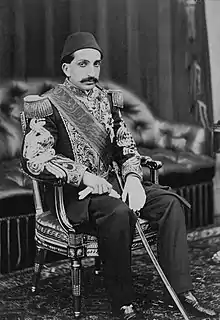

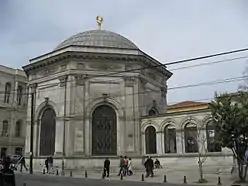

_p259_Sultan_Abdul_Hamid_II.jpg.webp)